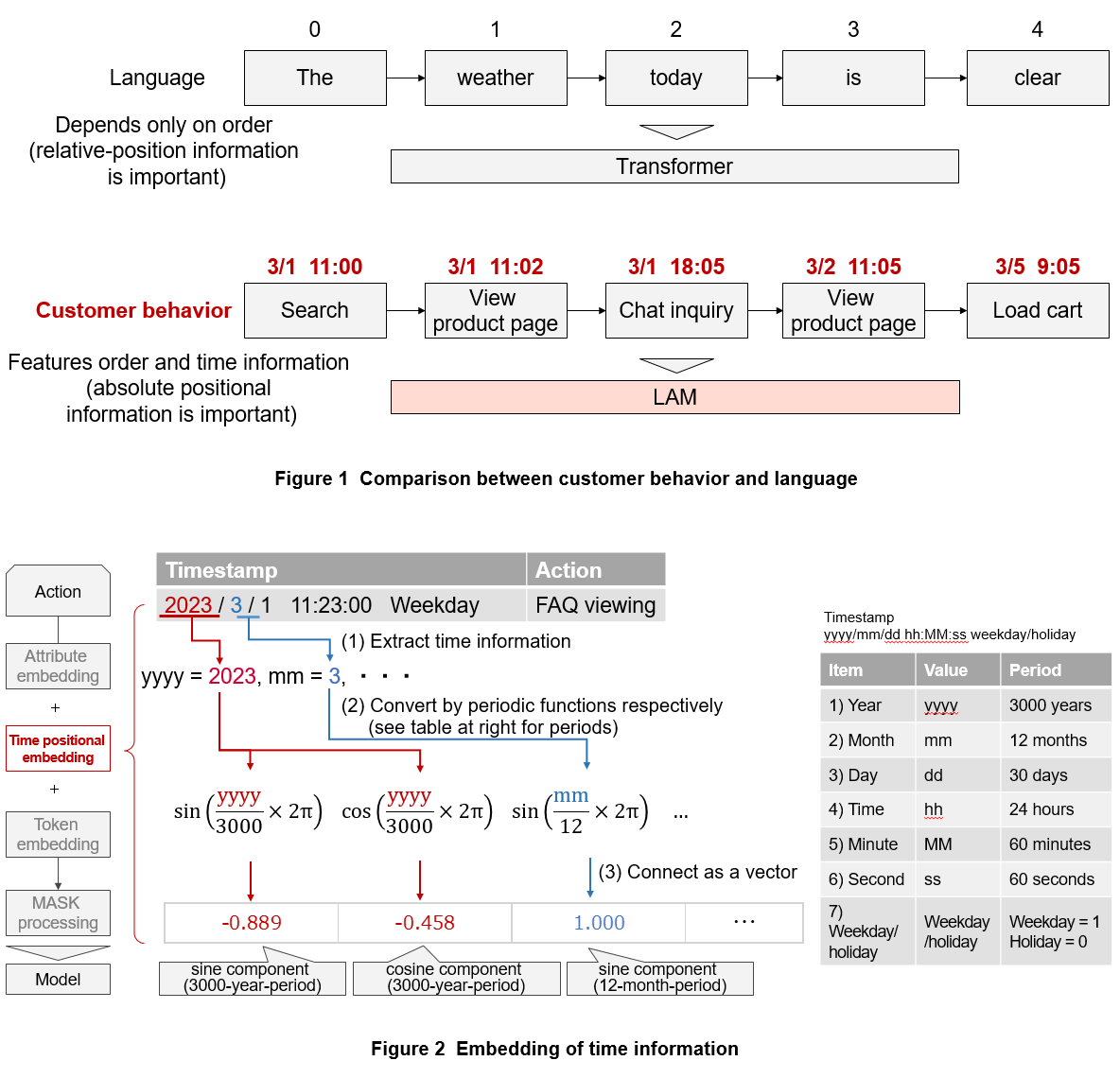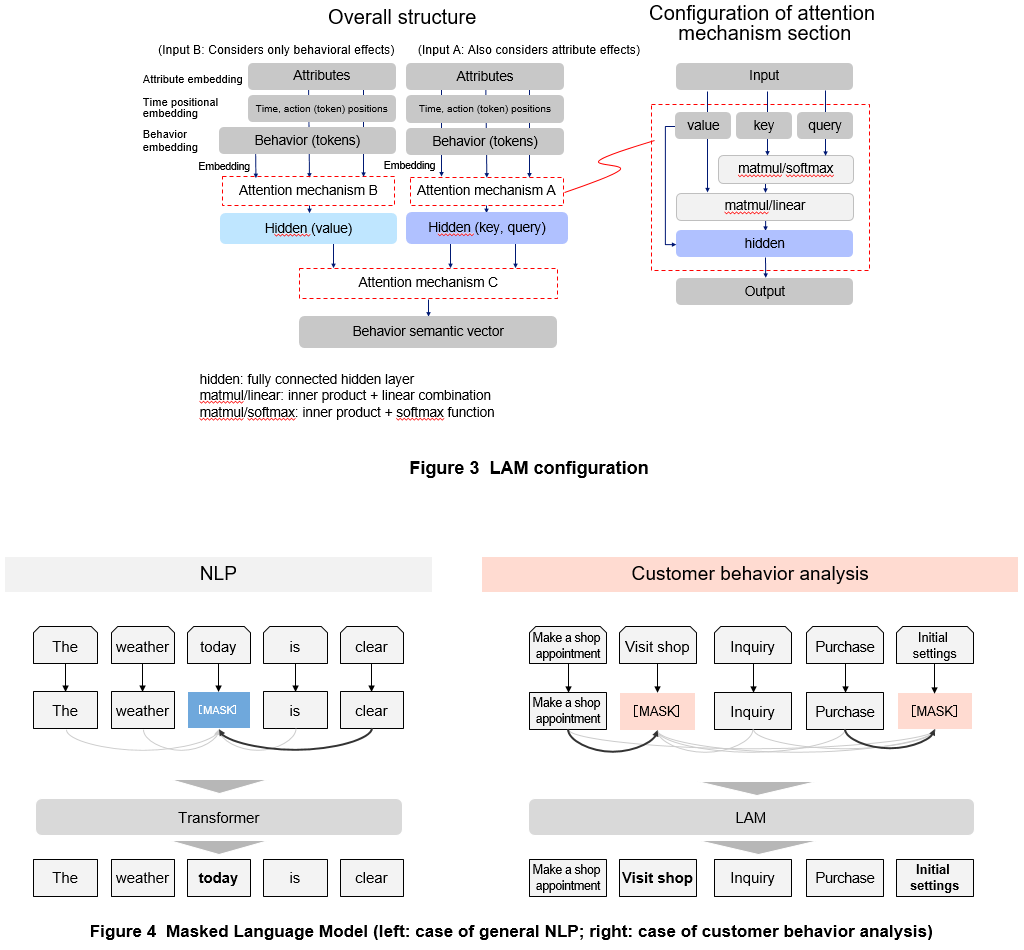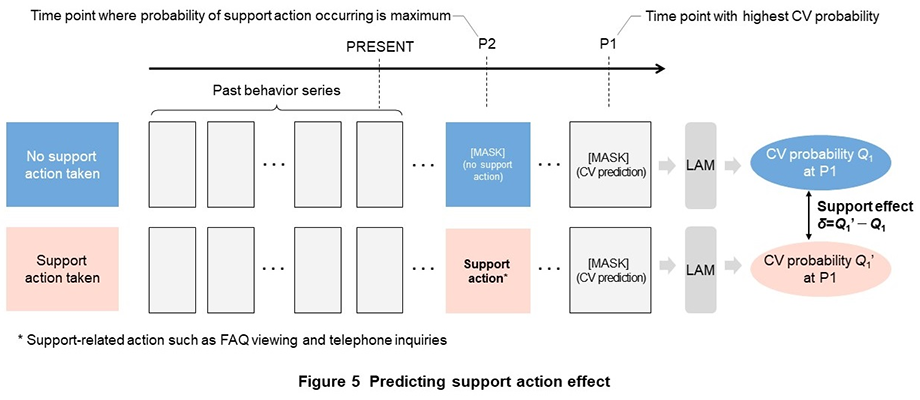Special Articles on AI for Customer Support in Diverse Fields
Customer Behavior Analysis for Support of Customer Procedures
Customer Experience Customer Support Series Analysis
Akihiro Chiba, Yoshiki Hayashi, Hiroki Asai and Tomohiro Nagata†1
Service Innovation Department
Tetsuya Shioda and Kensuke Fukushima†2
NTT Smart Data Science Center
†1 Currently, X-Tech Development Department
†2 Currently, Enterprise Business Department, NTT West Corporation
Abstract
Achieving detailed support for each and every customer requires an optimal method for extracting needs and issues from customer information such as attributes and behavior. In recent years, however, customer lifestyles and the services provided by NTT DOCOMO have become increasingly diversified and responding to customers in a finely tuned manner has become difficult. In this article, we describe our efforts at optimizing our response method in tune with each and every customer based on NTT DOCOMO AI.
01. Introduction
-
With the aim of providing an even better Customer Experience (CX), ...
Open

With the aim of providing an even better Customer Experience (CX), NTT DOCOMO is developing data analysis technology to achieve a high level of customer understanding. Specifically, we aim to use data analysis to quickly and accurately grasp the customer’s needs and issues, improve customer support based on that information, and provide an environment in which the customer can complete any procedures in a smooth and straightforward manner.
Customer support is broad in scope ranging from product purchases and service contracts to dealing with any problems that arise during their use. In this article, we focus on guidance for procedures tailored to the individual customer. For example, optimizing the presentation of information on a Web browser during an online procedure or personalizing the e-mail delivery of service offerings should contribute to a smooth customer procedure. To this end, NTT DOCOMO is using Artificial Intelligence (AI) to predict the best time and method of providing the support needed based on the customer’s situation and to improve the presentation of information tailored to the customer.
The conventional approach has been to determine the customer’s features based on attribute information such as age and gender and to present information accordingly. However, if conditions change even for the same customer (due, for example, to recently viewed promotional information or a previously completed procedure), the information needed will likewise change. It is therefore important to provide support that takes into account customer behavior that can change from moment to moment in addition to attribute information that changes only slightly over time.
Customer behavior can be observed at touchpoints between the customer and the company, and NTT DOCOMO has prepared many such touchpoints. These include visits to a docomo Shop, calls to an information center, and browsing through the docomo OnlineShop site. In addition, a new touchpoint in the form of an “online counter” has recently been setup [1]. However, establishing such a large number of touchpoints results in various types of customer behavior, which has made it difficult for the company to catch issues in a customer’s behavioral flow. For example, to determine the reason why a customer who, after purchasing a smartphone at a real docomo Shop after browsing the docomo OnlineShop site, made that actual visit would require knowledge of online behavior such as docomo OnlineShop browsing history and real-world behavior such as visits to a real docomo Shop.
Against the above background, NTT DOCOMO developed an analysis platform to collect and integrate customer behavior across customer touchpoints. In this way, it has become possible to grasp a series of customer actions and improve knowledge of the customer’s behavioral flow.
NTT DOCOMO also developed customer behavior analysis technology for grasping such customer behavior in a more efficient and highly accurate manner. The purpose of the technology is to provide advanced customer support by (1) predicting future customer behavior and (2) calculating the effect of provided support. For example, if a procedure that has the potential of occurring in the future could be predicted, a customer browsing a support site could be presented with replies that prioritize information related to that procedure thereby achieving support tailored to the customer. In addition, if the most effective reply from among those replies could be calculated, the order of displaying those replies could be optimized thereby prioritizing the information needed by the customer.
In this article, we describe in detail this customer behavior analysis technology that grasps customer behavior in a more efficient and highly accurate manner. Specifically, as elements that lie at the core of this technology, we describe “Large Action Models (LAMs)” developed by NTT Laboratories and “support-effect prediction function” for applying those models to customer support. We also introduce telephone-based guidance and support (telephone support) as an example of a specific method that can use this technology in NTT DOCOMO business operations.
-
2.1 LAM
Open

1) Overview
LAMs use the Transformer architecture [2] to learn the relationships among actions sequenced over time. Transformers are increasingly used in the field of Natural Language*1 Processing (NLP). They typically undergo self-supervised learning to learn the relationships between instances of a token*2 like a word. NTT DOCOMO, in partnership with NTT, is engaged in research and development of LAMs to apply the Transformer’s capabilities for analyzing customer behavior with the goal of improving its customer support approach [3].
As shown in Figure 1, just as language consists of a sentence of words, or tokens, customer behavior can also be treated as sequential data*3 if individual actions, such as inquiries and website viewings, are viewed as tokens. However, while the positions of words in language can be expressed as relative positions within an entire document, customer behavior differs greatly in the sense of being expressed as absolute positions based on dates and times.
Date and time information play an important role in customer behavior analysis. For example, specific types of behavior such as visits to actual shops may be concentrated in weekends while the frequency of viewing websites may differ greatly between daytime and nighttime depending on customers’ lifestyle. To understand customer behavior, it is essential to consider information that captures these periodic trends.
We therefore develop a time positional embedding mechanism to capture this periodicity using periodic functions (Figure 2). This mechanism breaks down date and time information into seven elements—year, month, day, time, minute, second, and weekday/holiday. Each element is transformed via a periodic function and then vectorized together. In addition to time positional embedding, attribute information such as the customer’s contract status and behavioral information such as the title of a viewed webpage are converted into vectors as attribute embedding and behavioral embedding, respectively. Embeddings are used as input to attention mechanisms*4. As shown in Figure 3, the overall structure of LAM consists of three attention mechanisms. Attention mechanism A has the role of considering the relationship among the customer’s attributes, behavior, and time (position). However, relying solely on attention mechanism A may lead to an overemphasis on attributes. To address this, attention mechanism B is incorporated, which takes only behavior embedding as input, thereby focusing mainly on behavioral information. Attention mechanism C integrates both attention mechanisms A and B to consider attributes and behaviors in a well-balanced manner.
2) Training Method
We use the Masked Language Model [4] to train model parameters. This model replaces a part of a sequence with a token representing an omission, such as the [MASK] symbol, and infers what should fill that position by considering neighboring tokens, thereby learning the relationship between tokens (Figure 4, left). In NLP, [MASK] replacements occur in a random manner to learn a token’s context. In behavior analysis presented here, in addition to random [MASK] replacement, tokens at the last part of the sequence are also replaced with [MASK] to increase the accuracy of predicting customer behaviors (tokens) in the future (Fig. 4, right). The objective is to efficiently learn how the order of earlier tokens relates to later tokens in the sequence.
3) Effectiveness Test
Before actually using this method in-house, we conducted an evaluation using open data [5][6] to test its effectiveness. In the evaluation, we used reviewed products as tokens to predict which products would be reviewed in the future. The results showed that Receiver Operating Characteristic-Area Under the Curve (ROC-AUC)*5 of standard Transformer and LAM was 0.693 and 0.734, respectively, indicating that LAM was more accurate. Based on the results, we conclude that embedding information related to the periodicity of the date and time is effective.
In this section, we described a method for predicting future behavior and reported the results from testing this method using open data. Providing advanced customer support involves not only predicting the customer’s future behavior but also providing meaningful support based on those predictions. NTT DOCOMO therefore devised a technique that evaluates the potential effectiveness of this support in advance and proposes highly effective support tailored to the customer.
2.2 Support-effect Prediction Function
To provide better CX, it is important to provide support tailored to the customer’s situation. Support-effect prediction function lets AI decide whether a customer needs support to complete their desired procedures based on their attributes and behavior. This determination uses LAM described above. Here, if a sequence that includes [MASK] is input, LAM predicts the probability that certain behavior will occur at that point of time corresponding to [MASK]. Setting a certain point in the future to [MASK] and inputting that sequence makes it possible to predict the probability of completing the customer’s desired procedure, i.e., Conversion (CV) at that point in the future. Furthermore, by interpolating and predicting behavior corresponding to support at time points before [MASK], it is possible to predict the probability of CV when support is provided. The effectiveness of support can therefore be surmised from the difference between the probability of CV when support is provided and when it is not.
We here describe the specific procedure referring to Figure 5. The boxes in the figure represent actions arranged in a time series. First, to calculate the probability of CV when no support action is taken, we replace actions following the PRESENT mark in the figure with [MASK] and determine the position with the highest probability of CV. Here, position P1 in the figure is estimated to have the highest probability of CV and the probability at this point is labeled as Q1. Next, to compute the probability of CV when support action is taken, we determine the position with the highest probability that support-related action such as FAQ viewing will occur at a position prior to P1. Here, it is estimated that position P2 has the highest probability that support-related action will occur. At this time, denoting the probability of CV at position P1 as Q1’, support effect δ can be expressed as Q1’—Q1. A large positive value of δ indicates that the probability of CV is high due to support while a large negative value of δ indicates that support has an adverse effect. Accordingly, by providing support when δ is equal to or greater than a certain value, or by determining δ for each support method and adopting the support method that is most effective, it becomes possible to provide support tailored to the customer’s situation.
- Natural language: A language such as Japanese or English. In this article, this mainly refers to text such as sentences.
- Token: In this article, refers to a single customer action such as viewing a page on a Web site or making a call to a contact center.
- Sequential data: Data consisting of a series of elements, such as character strings, audio waveforms, and purchase histories.
- Attention mechanism: A mechanism for learning the strength of association between tokens.
- ROC-AUC: An index that scores 1.0 when all predictions are correct and 0.5 when predictions are random; an adequate level of accuracy can generally be guaranteed for a score of 0.7 or greater.
-
3.1 Issues in Customer Support
Open

Enhancing customer support is important, but to this end, it is necessary to effectively use the limited resources available on the support-providing side. At NTT DOCOMO, we are working to provide enhanced online support to make access easier for customers, but interactive support over the telephone is still as effective as ever. If we can know which customers need support from NTT DOCOMO beforehand, we can proactively provide them the information they need to complete the procedure before they have problems. At NTT DOCOMO, we therefore applied LAM and the support-effect prediction function to telephone support.
In the past, telephone calls were made based on domain knowledge*6 focusing on customers who were thought to need telephone support, but a customer’s situation could not be fully understood by attributes alone. As a result, the limited human resources of call operators could not be effectively used. We therefore attempted to optimize these resources by using our customer behavior analysis technology to establish a mechanism for deciding the order of calling customers expected to have a high degree of need for telephone support.
3.2 Solutions through Customer Behavior Analysis Technology
To implement the above mechanism, customer behavior analysis technology has (1) a function for predicting a customer’s future CV and (2) a function for calculating the effect of support on CV. Here, “CV” refers to the procedure targeted by support and “support” refers to telephone support.
Functions (1) and (2) can be used to find customers for whom the procedure targeted by support has a high probability of execution (i.e., the customers are interested in the procedure targeted by support) and the support effect is high (i.e., customers need support).
3.3 Executing Support Based on Prediction Results and Effect
Based on predicted results, calls were made from NTT DOCOMO to customers for whom a support effect could be expected and support was then provided. Compared to the conventional support procedure that extracts target customers based on domain knowledge, the CV rate improved by using customer behavior analysis technology. We consider the reason for this is that it was effective to allocate customer support resources based on customer behavior to customers having a high probability of completing a procedure and who actually need support.
In addition, a customer who was provided support by telephone commented “I could not have completed the procedure on my own, so receiving this support was very helpful.” Furthermore, an operator who actually made such calls stated that customers for whom a high support effect was expected tended to desire such telephone support when a certain procedure was proposed to them. These evaluations, though qualitative in nature, indicate that NTT DOCOMO’s customer behavior analysis technology was effective in this business application.
- Domain knowledge: Knowledge or information such as trends and so forth about a target business or industry.
-
In this article, we described customer behavior analysis technology ...
Open

In this article, we described customer behavior analysis technology for analyzing the behavior of NTT DOCOMO customers and providing them with advanced support. In particular, we outlined LAM that makes up this technology, described a support-effect prediction function that we developed so that LAM could be applied to NTT DOCOMO business operations, and introduced an example of using this technology in customer telephone support.
It was shown that the CV rate improved with this customer behavior analysis technology and that our objective in providing support tailored to the customer was achieved. Going forward, we plan to apply this technology to various types of customer support.
-
REFERENCES
Open

- [1] NTT DOCOMO Press Release Materials: “Provision Begins of ‘DOCOMO Online Counter’ Online Customer Service—Enables Customers to Obtain Consultation On Procedures and Make Applications Online from Wherever Desired—,” Feb. 2023 (in Japanese).
https://www.docomo.ne.jp/info/news_release/2023/02/16_00.html - [2] A. Vaswani, N. Shazeer, N. Parmar, J. Uszkoreit, L. Jones, A. Gomez, L. Kaiser and I. Polosukhin: “Attention is All you Need,” Advances in Neural Information Processing Systems, Vol. 30, Dec. 2017.
- [3] A. Chiba, K. Fukushima, T. Shioda, Y. Hayashi, H. Asai, T. Nagata, M. Ishii, H. Kurasawa, I. Shibata and A. Sato: “Customer Behavior Analysis using BERT with a Periodic Attention Function,” IEICE General Conference, B-15-24, Mar. 2023 (in Japanese).
- [4] J. Devlin, M.-W. Chang, K. Lee and K. Toutanova: “BERT: Pre-training of Deep Bidirectional Transformers for Language Understanding,” Proc. of NAACL-HLT, pp. 4171—4186, May 2019.
- [5] J. McAuley, C. Targett, Q. Shi and A. Hengel: “Image-based Recommendations on Styles and Substitutes,” Proc. of SIGIR ‘15, Aug. 2015.
- [6] R. He and J. McAuley: “Ups and Downs: Modeling the Visual Evolution of Fashion Trends with One-Class Collaborative Filtering,” Proc. of WWW, Apr. 2016.
- [1] NTT DOCOMO Press Release Materials: “Provision Begins of ‘DOCOMO Online Counter’ Online Customer Service—Enables Customers to Obtain Consultation On Procedures and Make Applications Online from Wherever Desired—,” Feb. 2023 (in Japanese).








